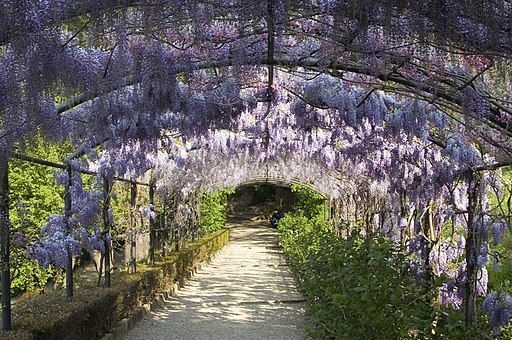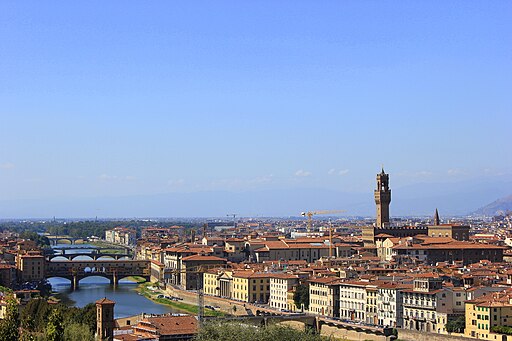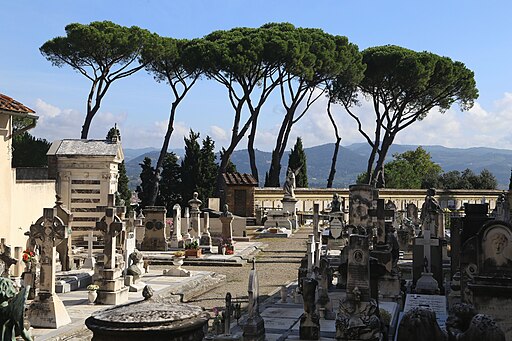| |
|
The Piazza de' Mozzi takes its name from the Mozzi family, one of the most important in Florence between the thirteenth and fourteenth centuries. The family, of well-known papal bankers, lived in the Palazzo dei Mozzi, located at the end of the square, with a turret that still scrutinizes the traffic on the bridge.
Palazzo Mozzi
Palazzo Mozzi or Palazzo de' Mozzi is an early Renaissance palace, located at the end of the Piazza de' Mozzi that emerges from Ponte alle Grazie and leads straight to the palace where via San Niccolò becomes via de' Bardi in the Quartiere of Santo Spirito (San Niccolò) in the Oltrarno section of Florence, region of Tuscany, Italy. The 13th-century palace housed the gallery of the highly successful antiquarian Stefano Bardini, of which the remnants were left to the commune, where they assembled the Museo Bardini or Mozzi Bardini, displaying Florentine art and artifacts up to the early Renaissance. The gardens elaborated against the hillside behind the palace were added mainly by Bardini.
|

|
Giardino Bardini, veduta su Palazzo Mozzi, retro, Oltrarno, Firenze [0]
|
History
The palazzo was built by the Mozzi family between 1260 and 1273[1] as a fortification for the Ponte alle Grazie.[2] The prominent Mozzi family had been persecuted in the past for its Guelph leanings. The palace in the 13th and 14th-centuries hosted prominent visitors to Florence such as Pope Gregory X, Robert, Duke of Anjou, and the Duke of Athens at the palazzo.[1] This may have been due to its protected location, outside of the city center, near the Porta San Niccolo.[3]
The palazzo was modified in the 14th century to a Renaissance house. The site changed hands during the 1500s, and the Mozzi family repossessed the site by 1551. During the 1700s and early 1800s, the palace was refurbished by the architect Gasparo Maria Paoletti, including the additions of some frescoes (1778) on the first floor.
With the extinction of the Mozzi family, the palace fell into disrepair, and was bought in 1880 by the Princess Vanda Carolath von Beuthen, then in 1913, by Stefano Bardini. The palace served as a gallery for the objects he had for sale, and a studio for his restorers. His will in 1922, required his heirs to convert his remaining collection into a cultural institution.
However, feuding of heirs retarded any progress towards this purpose until 1996, when the palace was acquired by the Commune. The palace façade has been restored to how it was expected to resemble in the 13th-century. The main façade has a coat of arms of Mozzi with a Cross of Toulouse. The interior contains architectural elements including portals from various city structures dismembered during the 19th-century Risanamiento of the city.[4] The State of Italy currently owns the palazzo.[5] It was closed in 1999 for nearly a decade of restoration and re-opened in April 2009 to host the Bardini Museum (Museo Bardini).
In the 16th century, a plot of land was purchased behind the palazzo and was used to grow an olive grove. The grove was transformed into the Giardino Bardini in the 19th century when the palazzo was purchased by Stefano Bardini.[2]
|
|
Map Palazzo Torrigiani Del Nero | Enlarge ma
p |
Museum Bardini
In 1881 Bardini acquired the deconsecrated church and convent of San Gregorio facing piazza dei Mozzi in the Oltrarno and set about transforming it into his opulent residence and restoration studio, Palazzo Bardini, now housing the Museo Bardini, with his collections of paintings, sculpture, most notably a marble Charity by Tino da Camaino, 15th- and 16th-century Italian furniture, ceramics, tapestry, arms; stringed and keyboard musical instruments, including one of only two surviving oval spinets by Bartolomeo Cristofori; Roman and Etruscan antiquities and 15th- and 16th-century architectural fittings, including paneled and painted ceilings, chimneypieces and door surrounds.[7] His example inspired his most successful protégé, Elia Volpi, to purchase and freely restore Palazzo Davanzati in the heart of Florence, and fill it with a similar range of art.
Among the works on display are:
Allegory of Charity, statue by Tino di Camaino
St Michael Archangel, painting by Antonio del Pollaiolo
Painted Crucifix, attributed to Bernardo Daddi
Madonna della Mela, carved wood statue by Donatello
Collections of decorative chests
Collections of weapons and armor
15th-century polychrome stuccoes and wooden sculpture
Collection of old musical instruments
Collections of frames, doors, ceramics, and painted ceilings
The second floor of the building exhibits the Corsi collection that comprises some works from the 12th to the 19th centuries, donated by Mrs. Carobbi, the widow of Corsi, in 1938.
|
 |
|
 |
|
 |
Antonio del Pollaiolo (1429–1498), San Michele Arcangelo abbatte il drago
|
|
Donatello o Luca della Robbia, Madonna della Mela |
|
Tino di Camaino, Allegory of Charity |
The Giardino Bardini
|
 |
| Florence | Giardino Bardini, view north towards the Duomo [1] |
| The Giardino Bardini is one of Florence's well kept secrets, offering fine views of Florence.
The garden is composed of three separate areas, each created in a different time period, which adds to the architectural and agricultural diversity. The park's center contains the grand staircase that was constructed in the 17th century. On one side of the staircase you can find the Anglo-Chinese garden created in the 19th century. The other side of the staircase hosts the garden's agricultural park.[8]
Access is gained via the Via de' Bardi, just over the road from the Museo Bardini in the Oltrarno district of the city, although the gardens exit onto the Costa di San Giorgio, onto which the Forte di Belevedere and the Giardino di Boboli connect in turn.
Bardini Museum | The museum is open from Saturday to Monday from 11-17.
Address: Bardini Museum, Via dei Renai, 37 (Ponte alle Grazie), Florence
The Bardini garden has three different access points: Costa San Giorgio 2, Via dei Bardi 2/red, and the access from the Boboli gardens
|
 |
|
 |
|
 |
| Firenze, Giardino Bardini - Vista nord verso il Duomo |
|
Firenze, Giardino Bardini, the grand baroque staircase that was constructed in the 17th century |
|
Firenze, Giardino Bardini, flowering wisteria |
Oltrarno and San Niccolò
Oltrarno, (or beyond the Arno), is one of Florence’s most authentic neighbourhoods. Oltrarno’s three historic quarters, San Niccolò, Santo Spirito, and San Frediano, are hip and trendy neighbourhoods, hidden away from the tourist crush. The bars and terraces that are mainly visited by the working locals in the morning and at noon, are populated by young people in the evening. In this district you will also find the only city beach of Firenze, la spiaggia sull'Arno, where you can sunbathe in the summer. River Urban Beach Terrazza Marasco is a great place to enjoy a relaxing, open-air sunset along the river banks.
From there you can walk up from Porto San Niccolò along the Viale Giuseppe Poggi, or climbing the stairs of Scalea del Monte alle Croci.
A pleasant walk in the heart of the left bank of the Arno river, takes you from the Ponte Vecchio all the way up to Piazzale Michelangelo.
Walking in Florence | Strolling through San Niccollò, from Ponte Vecchio to Piazzale Michelangelo
|
|
|
|
| |
|

Florence, Photo gallery
|
|
|
![Piazzale Michelangelo [Magnificent View on Ponte Vecchio]](https://upload.wikimedia.org/wikipedia/commons/thumb/4/4f/Florence_from_Piazzale_Michelangelo_-_panoramio_%286%29.jpg/512px-Florence_from_Piazzale_Michelangelo_-_panoramio_%286%29.jpg) |
|
 |
|
 |
Piazzale Michelangelo [Magnificent View on Ponte Vecchio]
|
|
Piazzale Michelangelo, con veduta del Duomo di Santa Maria del Fiore |
|
Panoramic view from Piazzale Michelangelo on Santa Croce |
 |
|
 |
|
 |
Piazzale Michelangelo |
|
Piazzale Michelangelo, con veduta del Ponte Vecchio e di Palazzo Vecchio |
|
Piazzale Michelangelo al tramonto, con veduta del Duomo di Santa Maria del Fiore, degli Uffizi, di Santa Croce e di Palazzo Vecchio
|
 |
|
 |
|
 |
| San Miniato al Monte, Cimitero Porte Sante |
|
Giardino delle Rose, Oltrarno, Firenze
|
|
San Miniato al Monte
|
 |
|
|
|
|
| |
|
|
|
|
Bardini Museum | Official Villa & Giardino Bardini website | Villa Bardini
Gardens in Tuscany | The Bardini Garden in Florence
Il giardino Bardini, uno specchio della storia fiorentina, Fondazione parchi monumentali Bardini e Peyron, CD-ROM, Ente Cassa di Risparmio di Firenze, 2001.
Repertorio delle Architetture Civili di Firenze - Palazzo Quaratesi | www.palazzospinelli.org
Walking in Florence | Strolling through San Niccollò, from Ponte Vecchio to Piazzale Michelangelo
Beautiful walk in one of the most authentic neighborhoods of Firenze, San Niccolò. The atmosphere of an authentic Florentine neighborhood still remains here.
|
|
 |
| |
|
Giardino Bardini, View east inbetween Porta San Niccolo and Piazzale Michelangelo
|
 |
Giardino Bardini, view on Florence [1]
|

[0] Foto di Sailko, licenziato in base ai termini della licenza Creative Commons Attribuzione-Condividi allo stesso modo 3.0 Unported
[1] Zucconi, Guido (1995). Florence: An Architectural Guide (November 2001 Reprint ed.). San Giovanni Lupatoto, Verona, Italy: Arsenale Editrice. p. 38. ISBN 88-7743-147-4.
[2] Palazzo Mozzi". Firenze-Oltrarno.net. March 12, 2004. Retrieved July 24, 2006.
[3] Florentine Palaces & Their Stories, by Janet Ross (1905), page 151-154.
[4] Palazzo Spinelli, Repertorio delle Architettura Civili di Firenze, entry on Palazzo Mozzi.
[5] "Gallery of Palazzo Mozzi-Bardini". Polo Museale Fiorentino. Ministry of Cultural Heritage. Archived from the original on May 12, 2006. Retrieved July 24, 2006.
[6] Museums in Florence, entry on Bardini Museum.
[7] Touring Club Italiano, Firenze e dintorni (Milan, 1964:376-79).
[8] Source: wp.eghn.org/en/bardini-garden-seven-centuries-of-florentine-history
|
This page uses material from the Wikipedia articles
Palazzo Mozzi, Stefano Bardini and
the Giardino Bardini, published under the GNU Free Documentation License. |
|
|